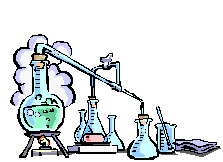| Sucrose Hydrolysis Using Sucrase |  |
INTRODUCTION:
In this lab, you will demonstrate the production of the enzyme sucrase (invertase) by yeast. The enzyme sucrase catalyzes the hydrolysis of the disaccharide sucrose to invert sugar. Invert sugar is a mixture of glucose and fructose, which are both monosaccharides. Yeast cannot directly metabolize (ferment) sucrose. For the yeast to utilize sucrose as an energy source, it must first convert it to the fermentable monosaccharides glucose and fructose.
Benedict’s solution is a test reagent that reacts positively with simple reducing sugars. All monosaccharides and most disaccharides are reducing sugars, possessing a free carbonyl group (=C=O). Sucrose is an exception in that it is not a reducing sugar. A positive Benedict’s test is observed as the formation of a brownish-red cuprous oxide precipitate. A weaker positive test will be yellow to orange. Both glucose and fructose test positive with benedict’s solution, sucrose does not.
MATERIALS NEEDED:
*Yeast filtrate solution
one 7 gram package active dry yeast per 80 mL distilled water
Ring stand and ring to hold funnel
Filtering funnel
Filter paper (fast speed)
**5% sucrose solution
5 grams sucrose per 95 mL distilled water
***5% glucose (dextrose) solution
5 grams dextrose per 95 mL distilled water
Benedict’s qualitative solution
Distilled water
Five 10-mL graduated cylinders (one for each solution)
7 test tubes 18 x 150 mm
Test tube holder
Test tube rack
2 400-mL beakers
Hot plate
PRE-LAB:
* To prepare a yeast filtrate solution, mix one package of active dry yeast with 80 mL of distilled water. Let stand for 20 minutes, stirring occasionally. Filter the resulting suspension and save the filtrate solution. This is your invertase extract. Refrigerate the extract if held overnight. Approximately enough for 8 labs.
**To prepare a 5% sucrose solution, dissolve 5 grams of sucrose in 95 mL of distilled water. This should be prepared shortly before use. Approximately enough for 4 labs.
***To prepare a 5% glucose solution, dissolve 5 grams of dextrose (this is the name used when dry) in 95 mL of distilled water. This should be prepared shortly before use. Approximately enough for 9 labs.
PROCEDURE:
1. Label 3 test tubes A1, A2, and A3, and place in the test tube rack. Place into the test tubes as follows:
- Into tube
A1
- , place
10 mL
- of 5% sucrose solution.
Into tube A2, place 10 mL of 5% sucrose solution and 4 mL of invertase extract.
Into tube A3, place 10 mL distilled water and 4 mL of invertase extract.
Thump the tubes to mix.
2. Put approximately 250 mL of 30 to 35 oC water into a 400-mL beaker. Incubate the three tubes in this warm water bath for 35 minutes.
3. Label 4 test tubes B1, B2, B3 and B4, and place in the test tube rack. Place 5 mL of Benedict’s qualitative solution into each tube. Now transfer to the B tubes as follows:
- Into tube
B1
- , transfer the contents of tube
A1
- .
Into tube B2, transfer the contents of tube A2.
Into tube B3, transfer the contents of tube A3.
Into tube B4, place 10 mL of 5% glucose solution.
Thump the tubes to mix.
4. Place tubes B1, B2, B3, and B4 into a boiling water bath. CAUTION: do not let the bath boil hard. Keep it just at the boiling point. After 3 or 4 minutes, remove the tubes and note whither any change is evident.
QUESTIONS AND OBSERVATIONS:
1. Did tube B1 test positive or negative?
2. What does this show?
3. Did tube B2 test positive or negative?
4. What does this show?
5. Did tube B3 test positive or negative?
6. What does this show?
7. Did tube B4 test positive or negative?
8. What does this show?
